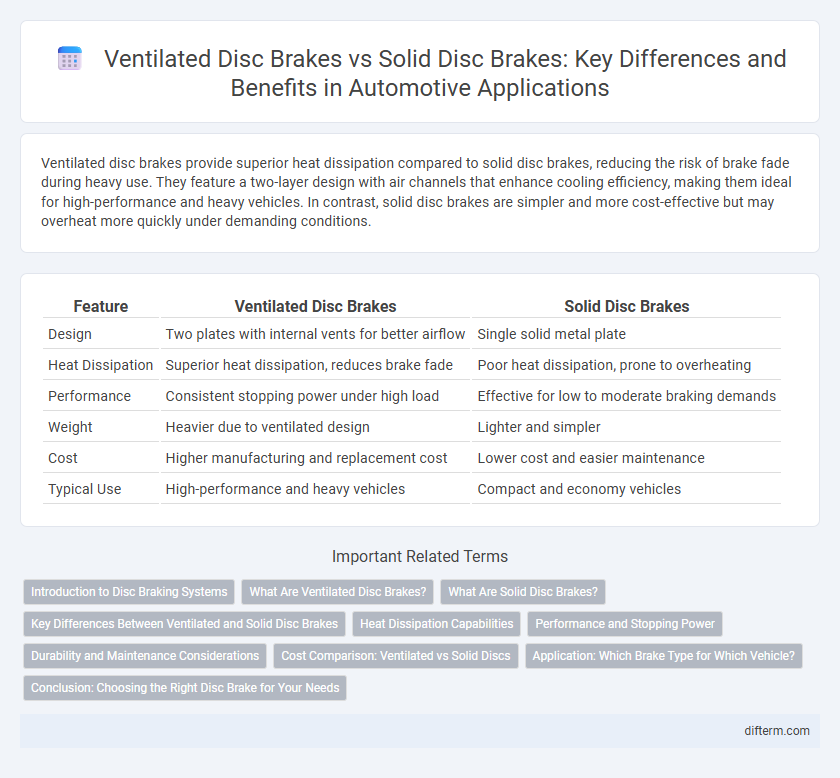Ventilated disc brakes provide superior heat dissipation compared to solid disc brakes, reducing the risk of brake fade during heavy use. They feature a two-layer design with air channels that enhance cooling efficiency, making them ideal for high-performance and heavy vehicles. In contrast, solid disc brakes are simpler and more cost-effective but may overheat more quickly under demanding conditions.
Table of Comparison
| Feature | Ventilated Disc Brakes | Solid Disc Brakes |
|---|---|---|
| Design | Two plates with internal vents for better airflow | Single solid metal plate |
| Heat Dissipation | Superior heat dissipation, reduces brake fade | Poor heat dissipation, prone to overheating |
| Performance | Consistent stopping power under high load | Effective for low to moderate braking demands |
| Weight | Heavier due to ventilated design | Lighter and simpler |
| Cost | Higher manufacturing and replacement cost | Lower cost and easier maintenance |
| Typical Use | High-performance and heavy vehicles | Compact and economy vehicles |
Introduction to Disc Braking Systems
Ventilated disc brakes feature a two-layer rotor design with internal vanes that promote airflow, significantly improving heat dissipation compared to solid disc brakes. Solid disc brakes consist of a single, solid rotor, making them simpler and typically more cost-effective but less efficient at managing high temperatures during heavy braking. Enhanced thermal management in ventilated discs reduces brake fade and increases overall braking performance, making them preferable for high-performance and heavy-duty automotive applications.
What Are Ventilated Disc Brakes?
Ventilated disc brakes feature a design with two friction surfaces separated by a vented, air-filled space that enhances heat dissipation during braking. This structure reduces brake fade and improves overall braking performance, especially under high-stress conditions common in automotive applications. Compared to solid disc brakes, ventilated discs maintain cooler operating temperatures, increasing durability and safety in vehicles.
What Are Solid Disc Brakes?
Solid disc brakes consist of a single, solid metal disc that clamps with brake pads to generate friction and slow the vehicle. These brakes offer durability and consistent performance under normal driving conditions but may experience quicker heat buildup compared to ventilated discs. Solid disc brakes are commonly used in rear-wheel setups and on smaller vehicles due to their simpler design and cost-effectiveness.
Key Differences Between Ventilated and Solid Disc Brakes
Ventilated disc brakes feature internal vanes that enhance heat dissipation, reducing brake fade during heavy or prolonged braking, unlike solid disc brakes which lack this cooling mechanism. Solid disc brakes are typically lighter and less expensive, making them suitable for lighter vehicles or less demanding driving conditions. Ventilated designs improve brake performance and longevity by maintaining lower operating temperatures, crucial for high-performance or heavy-duty automotive applications.
Heat Dissipation Capabilities
Ventilated disc brakes exhibit superior heat dissipation capabilities compared to solid disc brakes due to their internal vanes that facilitate airflow between the braking surfaces. This design effectively reduces brake fade by maintaining lower operating temperatures during high-stress conditions such as aggressive driving or repeated braking. Consequently, ventilated discs enhance braking performance and longevity in automotive applications requiring optimal thermal management.
Performance and Stopping Power
Ventilated disc brakes offer superior heat dissipation due to their dual-layer design with internal vents, reducing brake fade during high-performance driving. Solid disc brakes, while simpler and lighter, tend to retain more heat, which can decrease stopping power under sustained heavy braking. For vehicles requiring consistent braking performance, ventilated discs provide enhanced stopping power and reliability.
Durability and Maintenance Considerations
Ventilated disc brakes offer improved heat dissipation compared to solid disc brakes, resulting in enhanced durability under high-stress driving conditions and reduced risk of brake fade. Solid disc brakes tend to wear more quickly due to higher operating temperatures and may require more frequent maintenance or replacement. Choosing ventilated brakes can lead to longer service intervals and lower overall maintenance costs for performance vehicles and heavy-duty applications.
Cost Comparison: Ventilated vs Solid Discs
Ventilated disc brakes typically cost 20-30% more than solid disc brakes due to their complex design featuring internal vanes for heat dissipation. Solid discs offer a lower upfront cost but may incur higher long-term expenses from increased wear and reduced braking performance under heavy loads. Investing in ventilated discs provides better thermal management and durability, justifying the higher initial price for performance-oriented or heavier vehicles.
Application: Which Brake Type for Which Vehicle?
Ventilated disc brakes are ideal for high-performance vehicles and heavy-duty trucks due to their superior heat dissipation, which prevents brake fade during intense or prolonged braking. Solid disc brakes are commonly used in compact cars and light-duty vehicles where braking demands are moderate and cost efficiency is prioritized. Choice depends on vehicle weight, usage intensity, and required braking performance, with ventilated discs favored for aggressive driving and solid discs suitable for everyday urban commuting.
Conclusion: Choosing the Right Disc Brake for Your Needs
Ventilated disc brakes offer superior heat dissipation and reduced brake fade, making them ideal for high-performance and heavy-duty vehicles. Solid disc brakes provide reliable, cost-effective stopping power suitable for everyday driving and lighter vehicles. Selecting the right disc brake depends on driving style, vehicle type, and braking performance requirements.
ventilated disc brakes vs solid disc brakes Infographic

 difterm.com
difterm.com